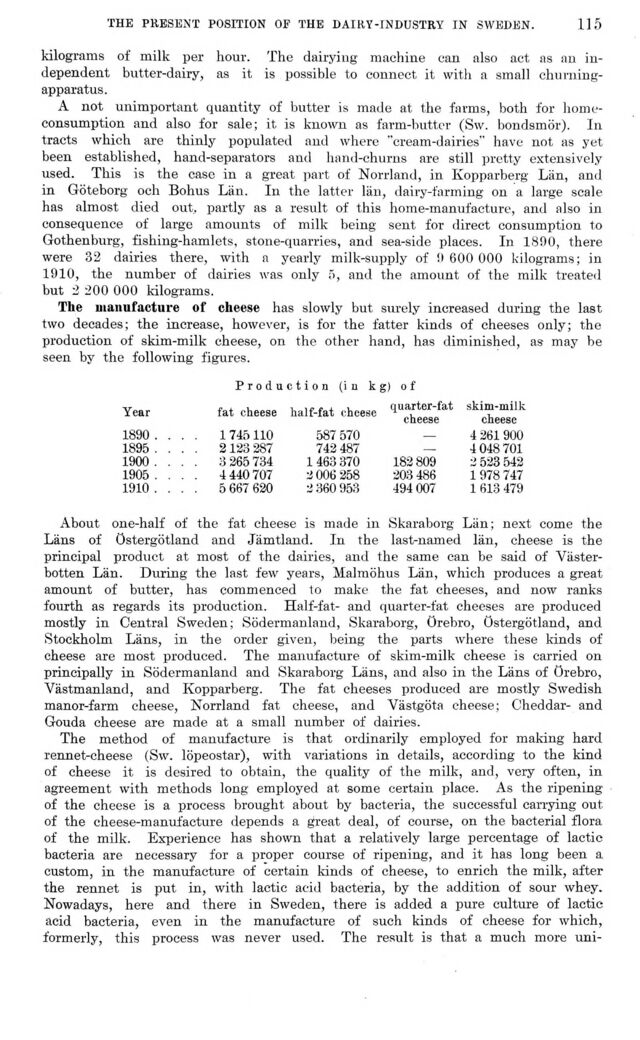
Full resolution (JPEG) - On this page / på denna sida - III. Rural Husbandry. Introd. by H. Juhlin Dannfelt - 3. Dairies and Dairy-Industry. By L. G. Thomé

<< prev. page << föreg. sida << >> nästa sida >> next page >>
Below is the raw OCR text
from the above scanned image.
Do you see an error? Proofread the page now!
Här nedan syns maskintolkade texten från faksimilbilden ovan.
Ser du något fel? Korrekturläs sidan nu!
This page has never been proofread. / Denna sida har aldrig korrekturlästs.
the present position of the dairy-industry in sweden.
115
kilograms of milk per hour. The dairying machine can also act as an
independent butter-dairy, as it is possible to connect it with a small
churning-apparatus.
A not unimportant quantity of butter is made at the farms, both for
home-consumption and also for sale; it is known as farm-butter (Sw. bondsmör). In
tracts which are thinly populated and where "cream-dairies" have not as yet
been established, hand-separators and hand-churns are still pretty extensively
used. This is the case in a great part of Norrland, in Kopparberg Län, and
in Göteborg och Bohus Län. In the latter län, dairy-farming on a large scale
has almost died out, partly as a result of this home-manufacture, and also in
consequence of large amounts of milk being sent for direct consumption to
Gothenburg, fishing-hamlets, stone-quarries, and sea-side places. In 1890, there
were 32 dairies there, with a yearly milk-supply of 9 600 000 kilograms; in
1910, the number of dairies was only 5, and the amount of the milk treated
but 2 200 000 kilograms.
The manufacture of cheese has slowly but surely increased during the last
two decades; the increase, however, is for the fatter kinds of cheeses only; the
production of skim-milk cheese, on the other hand, has diminished, as may be
seen by the following figures.
Production (in kg) of
Year fat cheese half-fat cheese clua,rter-fat skim-milk
cheese cheese
1890 .... 1745110 587 570 — 4 261900
1895 .... 2123 287 742 487 — 4 048 701
1900 .... 3 265 734 1 463 370 182 809 2 523 542
1905 .... 4 440 707 2 006 258 203 486 1 978 747
1910 .... 5 667 620 2 360 953 494 007 1 613 479
About one-half of the fat cheese, is made in Skaraborg Län; next come the
Läns of Östergötland and Jämtland. In the last-named län, cheese is the
principal product at most of the dairies, and the same can be said of
Västerbotten Län. During the last few years, Malmöhus Län, which produces a great
amount of butter, has commenced to make the fat cheeses, and now ranks
fourth as regards its production. Half-fat- and quarter-fat cheeses are produced
mostly in Central Sweden; Södermanland, Skaraborg, Örebro, Östergötland, and
Stockholm Läns, in the order given, being the parts where these kinds of
cheese are most produced. The manufacture of skim-milk cheese is carried on
principally in Södermanland and Skaraborg Läns, and also in the Läns of Örebro,
Västmanland, and Kopparberg. The fat cheeses produced are mostly Swedish
manor-farm cheese, Norrland fat cheese, and Västgöta cheese; Cheddar- and
Gouda cheese are made at a small number of dairies.
The method of manufacture is that ordinarily employed for making hard
rennet-cheese (Sw. löpeostar), with variations in details, according to the kind
of cheese it is desired to obtain, the quality of the milk, and, very often, in
agreement with methods long employed at some certain place. As the ripening
of the cheese is a process brought about by bacteria, the successful carrying out
of the cheese-manufacture depends a great deal, of course, on the bacterial flora
of the milk. Experience has shown that a relatively large percentage of lactic
bacteria are necessary for a proper course of ripening, and it has long been a
custom, in the manufacture of certain kinds of cheese, to enrich the milk, after
the rennet is put in, with lactic acid bacteria, by the addition of sour whey.
Nowadays, here and there in Sweden, there is added a pure culture of lactic
acid bacteria, even in the manufacture of such kinds of cheese for which,
formerly, this process was never used. The result is that a much more uni-
<< prev. page << föreg. sida << >> nästa sida >> next page >>